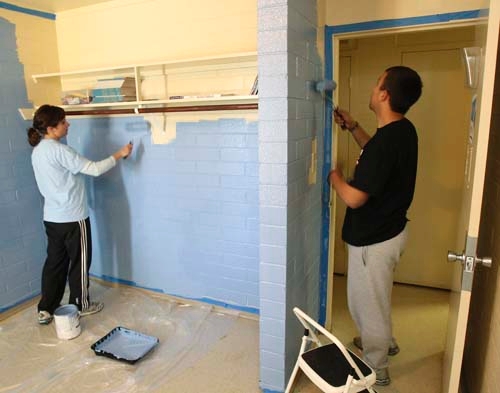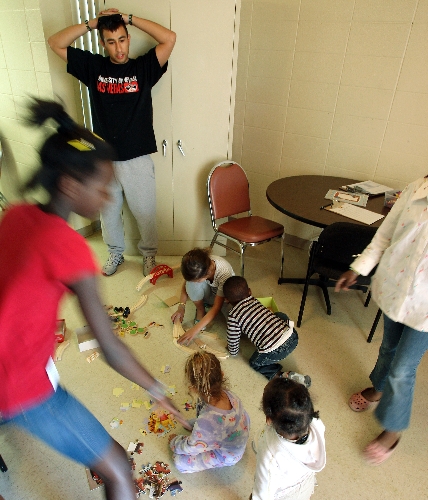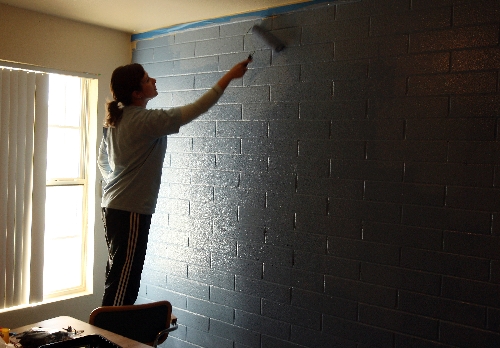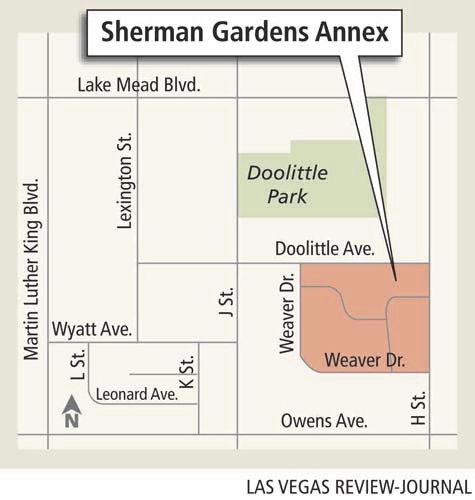Volunteers bring hope to apartment residents
The boy with the runny nose is sitting cross-legged on the floor, piecing together a puzzle of a cartoon bear.
His mama is in jail, he says.
His daddy?
"Dead. I can't help him get up."
The boy lives with his grandmother in a concrete block apartment in West Las Vegas but mostly takes care of himself.
"I tell everybody I'm with the Bloods, 'cuz they messin' with me," he says with pride.
The boy is 3 years old.
Welcome to Sherman Gardens Annex, a 160-unit family public housing complex known for being home to the Playboy Bloods, a street gang officials say has used violence, including murder, to defend its turf.
Ten members of the Playboy Bloods were indicted two years ago on charges ranging from trafficking crack cocaine to the slaying of a security guard.
Since then, things have gotten better, say those who live in the bare-bones complex at Doolittle Avenue and H Street. But not much.
"If you come down at the wrong time with the wrong people in the wrong colors, there could be shooting," says Latoya Moon, mother of two. "The kids could get caught in the crossfire."
Two hundred children live in Sherman Gardens Annex. Michael Flores wants to save them all.
The 23-year-old UNLV social work student is best known for being a community organizer and immigrant rights activist who orchestrates marches and other events in support of immigration reform.
But when public housing officials approached him a few weeks ago, asking him to open a "resource center" for kids in an empty apartment unit at Sherman Gardens Annex, he found himself unable to refuse.
"These kids are like crack. You get addicted to them," Flores says on a sunny Monday afternoon when he is wrangling nine of them, ranging in age from 1 to 13.
The baby girl bounces in Flores' lap as he oversees a toddler's construction of a wooden train track.
He asks the 13-year-old whether she has any homework, then reminds a 10-year-old girl to say "please" when asking for gummy bears.
Meanwhile, he is teaching the 3-year-old his colors.
"Pick out all the white pieces," he tells the boy, who is digging into a board game. Flores then swoops in with a wet wipe and cleans the 3-year-old's nose.
Flores gets paid nothing to operate the modest center for a few hours two days a week. He used his own money to buy coloring books, crayons and other supplies, and convinced a few friends to help renovate the apartment and mentor the kids.
One of those friends is Las Vegas police officer Melissa Lardomita, who showed up on her day off to help paint the center's "homework room," an empty bedroom in the small unit.
Lardomita, 34, has worked all over the city but has never come across children as starved for affection and toys as those at Sherman Gardens Annex.
"This is the first time I've seen kids to the point they're happy to play with a piece of tape," she says. "They hang on you. They really want your attention."
Lardomita is a member of the local Police Athletic League, a group dedicated to helping kids resist gangs and drugs through athletic and academic programs. When Flores told her about the new resource center, she couldn't say no, either.
"If people don't come in here and tell kids they can be anything they want to be, what will they become?" she says. "They have gang members, prostitutes and drug dealers as their role models. You have families who have been here their whole lives."
Lardomita is tapping her own contacts to give the kids free off-site tennis, boxing and mixed martial-arts classes.
"We want to provide them an opportunity to leave the neighborhood, and a place to come within the neighborhood," she says.
Flores hopes to eventually get grant money to hire some part-timers who can staff the center every afternoon. He plans to keep a file on each child at Sherman Gardens Annex, so staffers and volunteers will know their challenges.
"This kid called his mother a 'punk-ass' the other day," Flores says. "That's going in his file."
The long-term goal is to see fewer Sherman Gardens Annex kids dropping out of school, getting pregnant or turning to drugs. It's an uphill battle.
"This is a neighborhood that has been written off," Flores says. "It's a war zone out there. This is the biggest challenge of my life."
Many parents are wary of new people coming in.
"They want to know, 'What's it going to cost me? What do the cops want from us?' " Lardomita says.
Some parents are already thrilled with the new center.
"You have to have something for the kids to look forward to, especially in this neighborhood," Moon says.
Nicole Brasher, a 22-year-old mother of two who has lived in the area three years, volunteers at the new center.
"The heart of this community is the kids," she says. "They bring us all together."
Both Brasher and Moon say they know the neighborhood isn't the greatest but feel relatively safe there because they mind their own business.
"I hear about the problems but I never see them," Brasher says. "I don't know whose gang is what. I don't hang out with that type of people."
She was shocked earlier this month when a 26-year-old woman who lived in the adjacent Sherman Gardens public housing complex was killed. The woman's boyfriend was arrested on charges of murder and first-degree arson, accused of setting her apartment on fire.
"Where was I?" Basher asks incredulously. "That was right behind my apartment. I can see it from mine."
Resources such as the new center and a nearby computer lab recently opened by the Las Vegas Urban League could help kids elevate themselves out of public housing, says Moon, who has lived in the complex for two years.
"Some people come here and want to live for generations, but for some of us it's a stepping stone."
But some say no amount of resources will be enough to successfully combat the entrenched problems at Sherman Gardens Annex.
"You can't solve these problems with resources," says Carl Rowe, former director of the Southern Nevada Regional Housing Authority.
Rowe wanted to tear down the complex a couple years ago because "it's such a horrible place to live."
Federal housing officials balked at the idea, because demolition wasn't cost-effective, Rowe says. "They could get more useful years out of those buildings."
Rowe has long favored doing away with standard public housing, saying clustering low-income people together doesn't work and traps families in a cycle of poverty. He thinks residents should instead be given Section 8 rent-subsidy vouchers, which allow recipients to live wherever landlords are willing to accept the vouchers.
Those who support a voucher system over public housing say the vouchers allow people to move closer to job opportunities, day care facilities and better schools.
Demolition of the local Ernie Cragin public housing development, 250 units for low-income families near Bonanza Road and 28th Street, is almost complete. The residents of Ernie Cragin have been issued rent-subsidy vouchers and relocated over the past couple of years.
Other cities around the nation began experimenting with replacing public housing with vouchers years ago as a way to help people escape the concentrated poverty of "the projects." But the results have been mixed, and such demolitions have been criticized for destroying public housing communities, spreading crime and failing to lift people out of poverty.
In Memphis, Tenn., the demolition of public housing projects beginning in 1997 has in recent years been linked to the spread of crime throughout the wider community there, essentially reinforcing the stereotype about poor people destroying the suburbs.
There are valid arguments on both sides of the issue, Rowe says.
But, "if you can get rid of the center of that dysfunction, at least you get rid of the rallying point," he says.
Dora LaGrande, chairwoman of the board for the Southern Nevada Regional Housing Authority, believes that with enough help Sherman Gardens Annex can be transformed into a safe, healthy family community. She envisions it one day serving as a model for other valley public housing complexes.
"It's not really the residents" causing the problems, LaGrande says. "It's people coming from outside. The young ladies' boyfriends. One of the things we're doing is reaching out to some of the gang members."
The agency has joined with police, religious and community leaders in focusing efforts to "curtail the violence" at Sherman Gardens Annex because "people should not have to live like that," LaGrande says. "Everyone is interested in seeing children grow up to be educated, healthy, committed members of society."
She envisions a community where people have access to whatever they need "to get up and out of public housing if that's where they want to go."
Flores is committed to making his new center the starting point.
"The doors will be open every Monday and Thursday, no matter what," he says, then heads outside to kick a soccer ball around with the kids.
On the sidewalk out front, someone has drawn in chalk a picture of the sun peeking out from behind a cloud. Above that are the words, "The sky is the limit."
Contact reporter Lynnette Curtis at
lcurtis@reviewjournal.com or 702-383-0285.

























